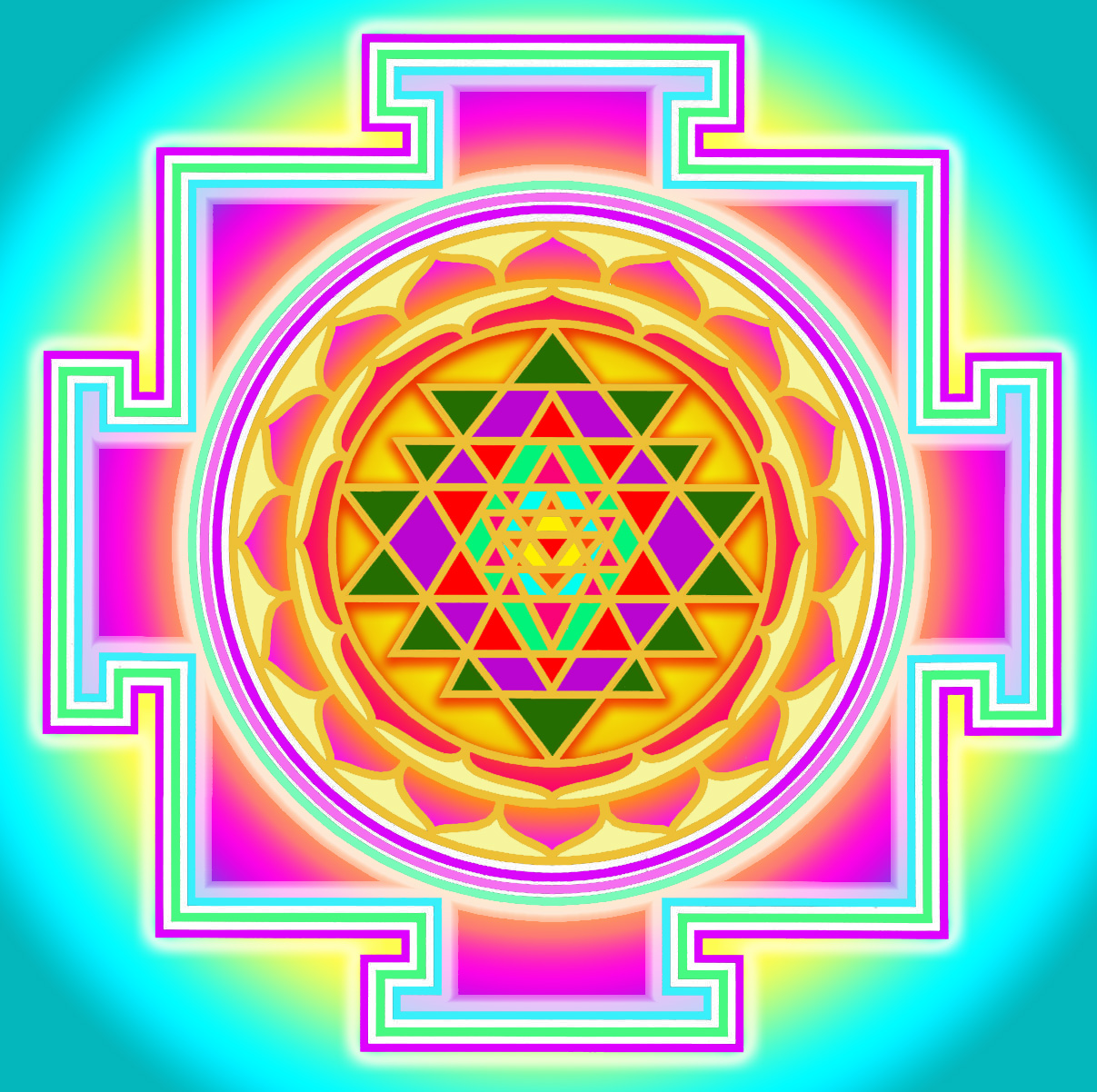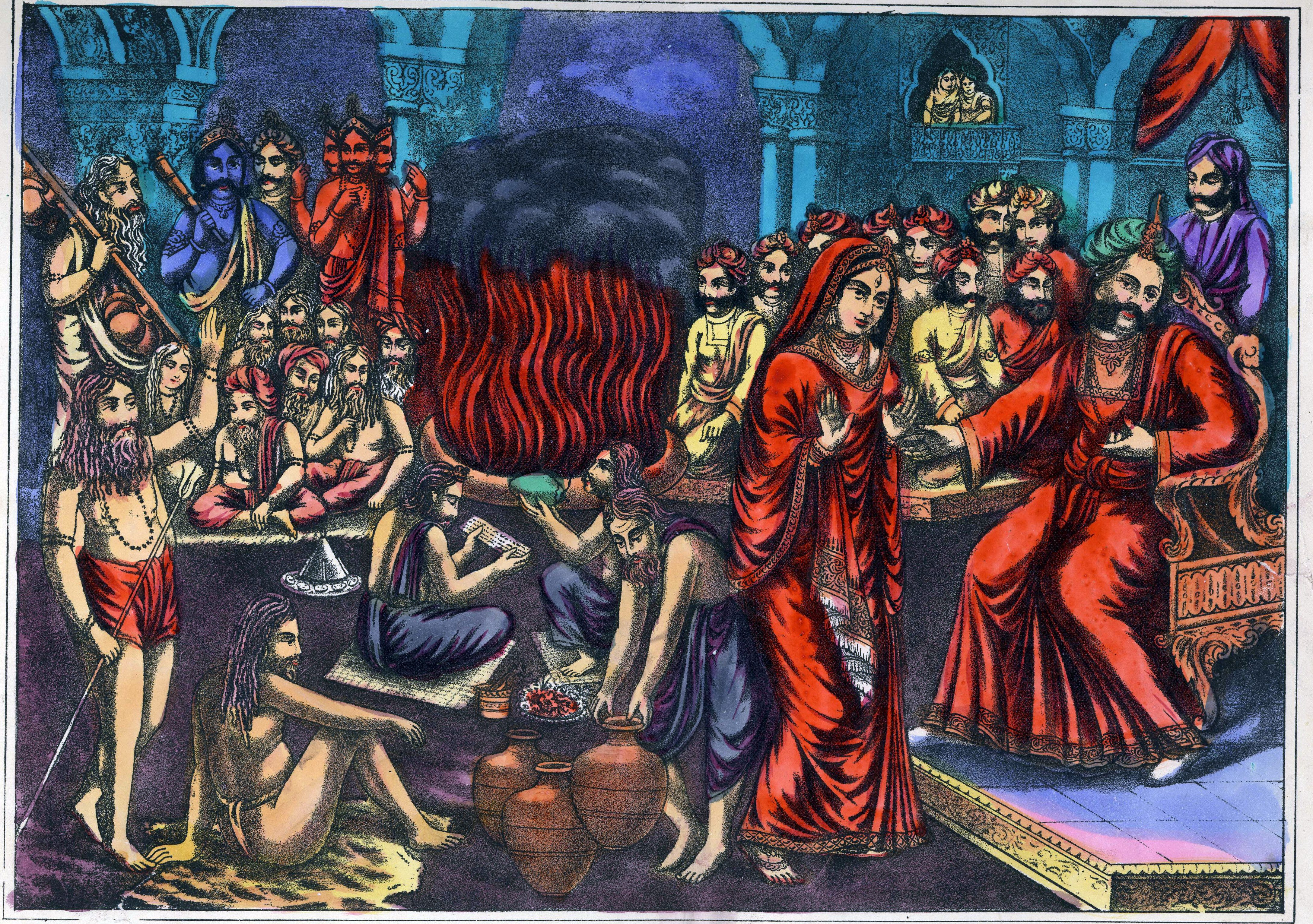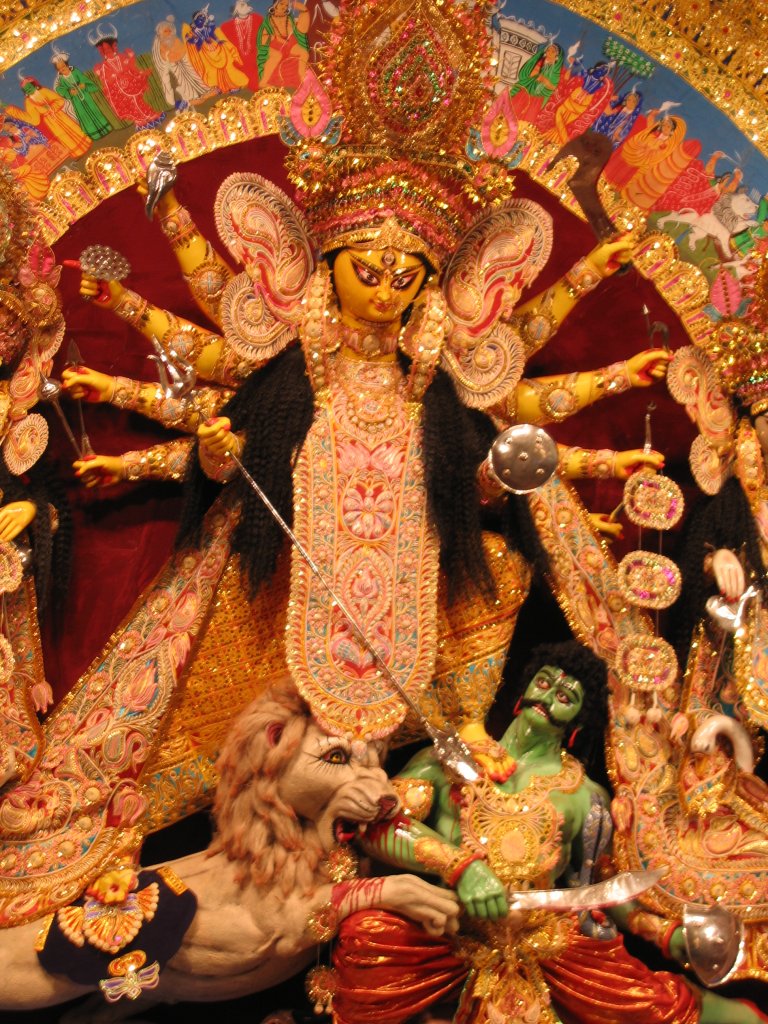|
Tvarita
Tvarita () is a goddess primarily featured in Tantras (Hinduism), Tantric Hinduism. She is depicted to be a member of the group of fifteen Yogini, yoginis called the nityas, and an aspect of Mahadevi, Adi Parashakti. Iconography Tvarita is depicted to be dark-complexioned. She has a crown on her head, which contains a peacock's tail. Her garments are made of leaves. She wears a necklace that is made of gunja flowers (rosary pea). The hem of her cloth, which is made of eight snakes, hangs down to the weight of her breasts. She is decked with armlets, a waist-chain, and anklets. She has three eyes, and has a fierce appearance. On one of her hands, she performs a gesture called the Varadamudra, varada mudra, and on the other, the Abhayamudra, abhaya mudra. Legend In her early sources, Tvarita is depicted to be a goddess who was best known for saving the lives of the victims of snakebites. She was eventually assimilated and identified with the goddesses of Durga and Kali. Tvarita ... [...More Info...] [...Related Items...] OR: [Wikipedia] [Google] [Baidu] |
Shaktism
Shaktism () is a major Hindu denomination in which the God in Hinduism, deity or metaphysics, metaphysical reality is considered metaphorically to be a woman. Shaktism involves a galaxy of goddesses, all regarded as different aspects, manifestations, or personifications of the divine feminine energy called ''Shakti''. It includes various modes of worship, ranging from those focused on the most worshipped Durga, to gracious Parvati, and the fierce Kali. After the decline of Buddhism in India, various Hindu and Buddhist goddesses were combined to form the Mahavidya, a Pantheon (religion), pantheon of ten goddesses. The most common forms of the Mahadevi worshipped in Shaktism include: Durga, Kali, Saraswati, Lakshmi, Parvati, and Tripura Sundari. Also worshipped are the various Gramadevatas across the Indian villages. Shaktism also encompasses various Tantra#Śaiva and Śākta tantra, tantric sub-traditions, including Vidyapitha and Kulamārga. Shaktism emphasizes that intense ... [...More Info...] [...Related Items...] OR: [Wikipedia] [Google] [Baidu] |
Sri Yantra
The Sri Yantra, Shri Yantra, or Shri Chakra (Sanskrit: श्री यन्त्र, IAST: śrī yantra) is a form of mystical diagram (''yantra'') used in the Shri Vidya school of Hinduism. Comprising nine interlocking triangles, it embodies complex symbolism. Four upward triangles signify Shiva, while five downward triangles represent Shakti, encompassing the cosmic and human realms around a central point called the bindu. This configuration is sometimes termed the "Navayoni Chakra". The Sri Yantra holds great significance in the Shri Vidya school, central to its worship. It symbolizes the union of masculine and feminine divine energies. The triangles, varying in size, form 43 smaller triangles in concentric levels, mirroring the cosmos. The power point (Bindu (symbol), bindu) stands as the cosmic center, encompassed by concentric circles with lotus petal patterns denoting creation and life force. These elements, set within an earth square, depict a temple with doors to diff ... [...More Info...] [...Related Items...] OR: [Wikipedia] [Google] [Baidu] |
Agni Purana
The ''Agni Purana'', (, ) is a Sanskrit text and one of the eighteen major Puranas of Hinduism. The text is variously classified as a Purana related to Shaivism, Vaishnavism, Shaktism and Smartism, but also considered as a text that covers them all impartially without leaning towards a particular theology. The text exists in numerous versions, some very different from others. The published manuscripts are divided into 382 or 383 chapters, containing between 12,000 and 15,000 verses. The chapters of the text were likely composed in different centuries, with earliest version probably after the 7th-century,Thomas Green (2001). ''Martial Arts of the World: An Encyclopedia'', ABC-CLIO, , page 282 but before the 11th century because the early 11th-century Persian scholar Al-Biruni acknowledged its existence in his memoir on India. The youngest layer of the text in the ''Agni Purana'' may be from the 17th century. The ''Agni Purana'' is a medieval era encyclopedia that covers a diverse ... [...More Info...] [...Related Items...] OR: [Wikipedia] [Google] [Baidu] |
Daksha Yajna
Dakṣayajña is an important event in Hindu mythology that is narrated in various Hindu scriptures. It refers to a yajna (ritual-sacrifice) organised by Daksha, where his daughter, Sati, immolates herself. The wrath of the god Shiva, Sati's husband, thereafter destroys the sacrificial ceremony. The tale is also called Daksha-Yajna-Nasha ("destruction of Daksha's sacrifice). The legend forms the liturgical basis of the establishment of the Shakti Pithas, the temples of Mahadevi, the supreme deity of Shaktism. It also becomes a prelude to the legend of Parvati, Sati's reincarnation, who later marries Shiva. The tale is mainly told in the '' Vayu Purana''. It is also mentioned in the ''Kasi Kanda'' of the ''Skanda Purana'', the '' Kurma Purana'', '' Harivamsa Purana,'' and the ''Padma Purana''. The ''Linga Purana'', ''Shiva Purana'', and '' Matsya Purana'' also detail the incident. Variations of the legend may be observed in later Puranas, each text lending a superior account to ... [...More Info...] [...Related Items...] OR: [Wikipedia] [Google] [Baidu] |
Virabhadra
Virabhadra (), also rendered Veerabhadra, Veerabathira, and Veerabathiran, is a fierce form of the Hindu god Shiva. He is created by the wrath of Shiva, when the deity hurls a lock of his matted hair upon the ground, upon hearing of the self-immolation of his consort, Sati (goddess), Sati, at the Daksha yajna.the Horse-sacrifice of the Prajapati Daksha Mahabharata, The Mahabharata translated by Kisari Mohan Ganguli (1883–1896), Book 12: Santi Parva: Mokshadharma Parva: Section CCLXXXIV. p. 315 Mahadeva created from his mouth a terrible Being whose very sight could make one's hair stand on its end. The blazing flames that emanated from his body rendered him exceedingly awful to behold. His arms were many in number and in each was a weapon that struck the beholder with fear. p. 317. “I am known by the name of ... [...More Info...] [...Related Items...] OR: [Wikipedia] [Google] [Baidu] |
Vaishno Devi
Vaishno Devi (also known as Mata Rani, Trikuta, Ambe and Vaishnavi) is a manifestation of the Hindu mother goddess. She is worshipped as a combined avatar of the goddesses Mahakali, Mahalakshmi, and Mahasarasvati. Origin Purāṇa In the Varāha Purāṇa's Triśakti Māhātmya, she originated from the goddess Trikalā and slayed the asura Mahiṣāsura on Śataśṛṅga Parvata where the current Trikūṭa Dhāma of Vaiṣṇōdēvī is situated. Pāñcarātra The Lakṣmīnārāyaṇa Saṃhitā's Kṛtayuga Santāna and Dvāparayuga Santāna calls her "Māṇikī", the Śakti of Kalki, as she resides on Māṇika Parvata. Mythology It is said that when Bhairavnath ran after Vaishno Devi to catch her, she approached a cave in the hills and summoned Hanuman. She told him, "I would do penance in this cave for nine months, till then you should not allow Bhairavnath to enter the cave." Hanuman obeyed her orders. Today the cave is known as Ardha Kunwari. Temple ... [...More Info...] [...Related Items...] OR: [Wikipedia] [Google] [Baidu] |
Chamunda
Chamunda (, ), also known as Chamundeshwari, Chamundi or Charchika, is a fearsome form of Chandi, the Hindu mother goddess, Mahadevi and is one of the seven Matrikas.Wangu p.72 She is also one of the chief Yoginis, a group of sixty-four or eighty-one Tantric goddesses, who are attendants of the warrior goddess Parvati.Wangu p.114 The name is a combination of Chanda and Munda, two demons whom Chamunda killed. She is closely associated with Kali, another fierce aspect of Parvati. She is identified with goddesses Parvati, Kali or Durga. The goddess is often portrayed as residing in cremation grounds or near holy fig trees. The goddess is worshipped by ritual animal sacrifices along with offerings of wine. The practice of animal sacrifices has become less common with Vaishnavite influences. Origins Ramakrishna Gopal Bhandarkar says that Chamunda was originally a tribal goddess, worshipped by the tribals of the Vindhya mountains in central India. These tribes were known to ... [...More Info...] [...Related Items...] OR: [Wikipedia] [Google] [Baidu] |
Katyayani
''Katyayani'' (कात्यायनी) is an aspect of Mahadevi and the slayer of the tyrannical demon Mahishasura. She is the sixth among the Navadurgas, the nine forms of Hindu goddess Durga who are worshipped during the festival of Navaratri. She is depicted with four, ten or eighteen hands. This is the second name given to the goddess Adi Parashakti in Amarakosha, the Sanskrit lexicon (Goddess Parvati names- Uma, Katyayani, Gauri, Kali, Haimavati, Ishwari). In Shaktism, she is associated with the fierce forms of Shakti or Durga, a warrior goddess, which also includes Bhadrakali and Chandika. She is traditionally associated with the colour red, as with Parvati, the primordial form of Shakti, a fact also mentioned in Patanjali's Mahabhashya on Pāṇini, written in 2nd century BCE. She is first mentioned in the Taittiriya Aranyaka part of the Yajurveda. The Skanda Purana mentions her being created out of the spontaneous anger of Gods, which eventually led to slaying ... [...More Info...] [...Related Items...] OR: [Wikipedia] [Google] [Baidu] |
Bhadrakali
Bhadrakali (IAST: Bhadrakālī; ) is an important goddess, mainly worshiped by Hindus, and is a form of Kali. She is considered to be the auspicious and fortunate form of Adi Shakti or Durga, the supreme mother who protects the good, known as ''Bhadra or Bhadra Bhagavathy''. She is worshipped predominently in the South indian state of Kerala and Nashik. In Vaishnavism, Bhadrakali is among the many epithets of Yogamaya, the internal potency of illusion of the supreme preserver deity, Vishnu. In Shaivism, she accompanies Virabhadra, a form of Shiva, as manifestations of Shiva's wrath. Etymology The name Bhadra comes from Sanskrit. In Sanskrit, "bhadra" means "auspicious" or "fortunate". Another interpretation traces the name to the Sanskrit root word (Beeja akshara) "bha" and "dra". The letter "bha" signifies "delusion" or "maya", while "dra" is used as a superlative meaning "the most" or "the greatest". Together, "bhadra" may mean "maha maya" or "great delusion". Forms Acc ... [...More Info...] [...Related Items...] OR: [Wikipedia] [Google] [Baidu] |
Shiva Purana
The ''Shiva Purana'' (original Sanskrit title: Śivapurāṇa (शिवपुराण) and Śivamahāpurāṇa (शिवमहापुराण) is one of eighteen major texts of the '' Purana'' genre of Sanskrit texts in Hinduism, and part of the Shaivism literature corpus. It primarily revolves around the Hindu god Shiva and goddess Parvati, but references and reveres all gods. The ''Shiva Purana'' asserts that it once consisted of 100,000 verses set out in twelve Samhitas (Books); however, the Purana adds that it was abridged by Sage Vyasa before being taught to Romaharshana. The surviving manuscripts exist in many different versions and content, with one major version with seven books (traced to South India), another with six books, while the third version traced to the medieval Bengal region of the Indian subcontinent with no books but two large sections called ''Purva-Khanda'' (Previous Section) and ''Uttara-Khanda'' (Later Section). The two versions that include books, ... [...More Info...] [...Related Items...] OR: [Wikipedia] [Google] [Baidu] |
Asura
Asuras () are a class of beings in Indian religions, and later Persian and Turkic mythology. They are described as power-seeking beings related to the more benevolent Devas (also known as Suras) in Hinduism. In its Buddhist context, the word is translated as "titan" or " antigod". According to Hindu texts, the asuras are in constant fear of the devas. Asuras are described in Indian texts as powerful superhuman demigods with good or bad qualities. In early Vedic literature, the good Asuras are called '' Adityas'' and are led by Varuna, while the malevolent ones are called '' Danavas'' and are led by Vritra. In the earliest layer of Vedic texts, Agni, Indra and other gods are also called Asuras, in the sense of their being "lords" of their respective domains, knowledge and abilities. In later Vedic and post-Vedic texts, the benevolent gods are called ''Devas'', while malevolent Asuras compete against these Devas and are considered "enem ... [...More Info...] [...Related Items...] OR: [Wikipedia] [Google] [Baidu] |
Brahmanda Purana
The ''Brahmanda Purana'' () is a Sanskrit text and one of the eighteen major Puranas, a genre of Hindu texts. It is listed as the eighteenth Maha-Purana in almost all the anthologies. The text is also referred in medieval Indian literature as the Vayaviya Purana or Vayaviya Brahmanda, and it may have been same as the Vayu Purana before these texts developed into two overlapping compositions. The text is named after one of the cosmological theories of Hinduism, namely the "Cosmic Egg" ( Brahma-Anda). It is among the oldest Puranas, the earliest core of text maybe from 4th century CE, continuously edited thereafter over time and it exist in numerous versions. The Brahmanda Purana manuscripts are encyclopedic in their coverage, covering topics such as Cosmogony, Sanskara (Rite Of Passage), Genealogy, chapters on ethics and duties (Dharma), Yoga, geography, rivers, good government, administration, diplomacy, trade, festivals, a travel guide to places such as Kashmir, Cuttack, Kanchi ... [...More Info...] [...Related Items...] OR: [Wikipedia] [Google] [Baidu] |








